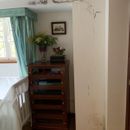Moisture attack – walls and slab
Hello everyone;
I am currently rehabilitating this old house (1930) in climate zone 4. This bedroom will serve as a spare bedroom in a vacation house.
The walls are made of stone and the slab made of concrete. A few years ago stucco was applied over the walls and painted over. The wood tiles on the floor are directly glued to the concrete slab.
The external wall (visible in the attached image) is partially in contact with the ground. There is no capillary break on the slab. Although the moisture problems are well visible in the image, there is no record of bulk water entering the room through the walls or slab.
It is not possible to intervene from the outside to provide any capillary break or waterproof to the walls.
The goal is to make this room more aesthetically pleasing, questions related to energy efficiency are not being considered. My ideas are:
Slab – Dimple mat over the concrete slab with the seams taped. A board of plywood over the dimple mat, screwed to the concrete. Same wood tiles (see image attached) glued to the plywood with non-modified mortar.
Slab Option #2 – XPS against the slab. A board of plywood over the XPS, screwed to the concrete. Same wood tiles glued to the plywood.
Walls – Really diffuse ideas here: XPS against the wall? uninsulated non-paper faced drywall? More vapour permeable paint?
I would like hearing from you regarding the treatment to apply on the walls and slab.
Thank you !
Robert
GBA Detail Library
A collection of one thousand construction details organized by climate and house part










Replies
Hi Robert,
Your description (and the photo) suggest a rising damp issue. I'm not sure any of your proposed fixes will deliver the results you are looking for. To address rising damp, see this article for additional information: https://www.greenbuildingadvisor.com/article/dealing-with-rising-damp-in-building-reconstruction